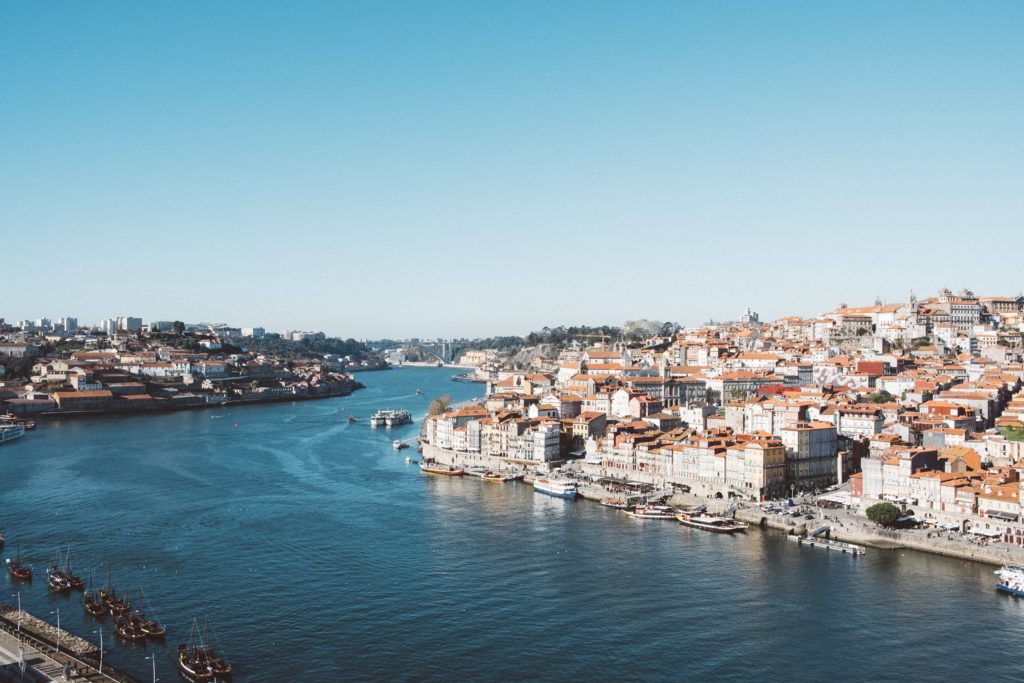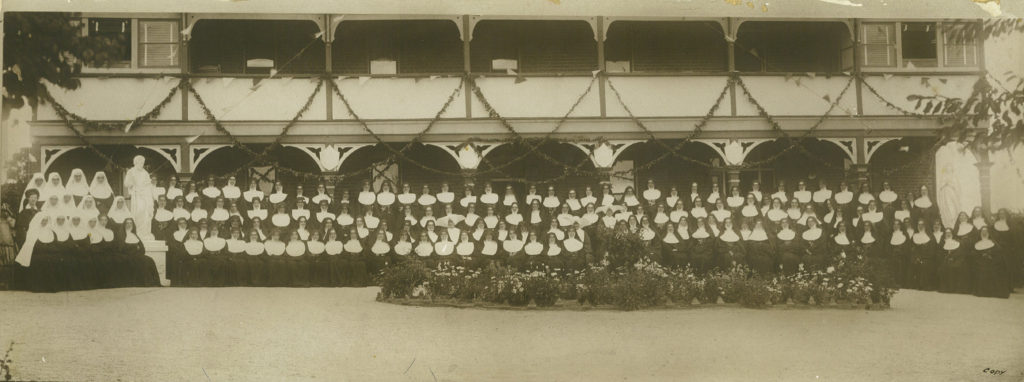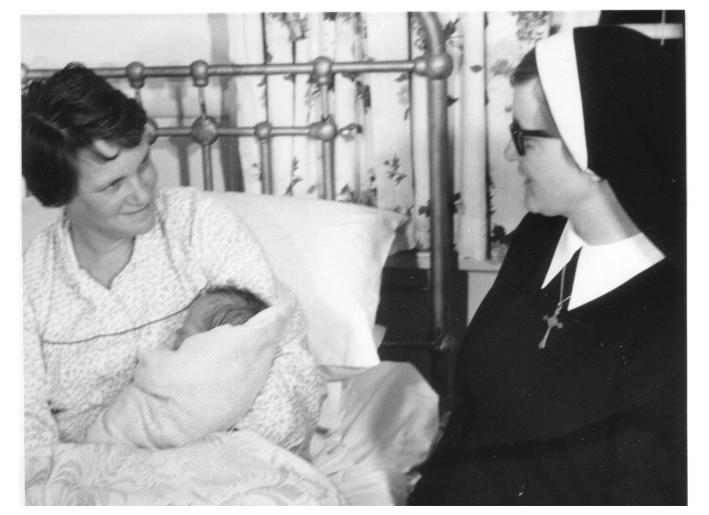Perthville Foundation Day 1872
July 16, 2019
Honouring the Perthville Story – Foundation Day, 16 July 1872
The most common name for a Catholic School in New South Wales (NSW) is St Joseph’s. Currently 77 (one in every eight), NSW Catholic schools bear the name of Joseph. The first St Joseph’s Catholic School in NSW was begun on 16 July 1872 in a church at The Vale (later re-named Perthville), a village near Bathurst. On this day a community of Sisters of Saint Joseph comprising Sisters Teresa MacDonald, Joseph Dwyer, Hyacinth Quinlan and the prospective postulant, Ada Braham started the first Josephite convent and school in NSW. They were waved off in Adelaide by both Fr Julian Woods and Mary MacKillop to extend the mission to poor and isolated families.
Click here to continue reading
Photos courtesy of Sr Therese McGarry. Used with permission.
Refugee Week Awareness Raising
July 10, 2019Recently, students at Sacred Heart College, New Town (Tasmania) and Mount St Joseph, Milperra (New South Wales) celebrated Refugee Week 2019.
See below how the students celebrated…
Sacred Heart College
The student leaders at Sacred Heart College were very proud of their work in organising the school’s Refugee Week assembly. They were inspired by messages from JJAMM.
It was one of the most powerful assemblies the students and teachers ever experienced whereby the student leaders arranged students in Year 4 to draw their journey to Australia, and then they had the courage to speak about their story using their picture to refer to.
The ‘Dots’ story was also enacted.
View the story pictures and the ‘Dots’ story provided below:
Sacred Heart College Refugee Week PowerPoint (PDF)
Mount St Joseph
The Mount St Joseph community showed their support for Refugee Week by creating a large banner for the students to place their hand print and name to rally against government policy that enforces the detention of people seeking asylum. Throughout the week videos of refugee people telling their stories were played on the school noticeboard.
The next task for the students is to sign a petition to take to their local Member of Parliament and bring the banner they created. The celebration was a great success!
You’re invited to view photos of the celebration below:
PowerPoint presentation (PDF) provided by Sacred Heart College, New Town. Used with permission.
Photos provided by Mount St Joseph, Milperra. Used with permission.
Commemorating World Environment Day
July 9, 2019Recently, students at St Joseph’s Catholic High School, Albion Park (New South Wales), St Mary MacKillop College, Swan Hill (Victoria) and Mary MacKillop College, Nundah (Queensland) commemorated World Environment Day 2019.
You’re invited to view the initiatives the students completed below…
St Joseph’s Catholic High School, Albion Park
The St Joseph’s community participated in a bake-off on World Environment Day to raise awareness of environmental issues currently facing our young people. Students and teachers baked cakes, slices and cupcakes, many of which had an “enviro” theme. Some staff even considered how sustainable their baking products were, trying to use Fair Trade and environmentally friendly products where possible.
Students were also able to enter the Waste-Free Lunchbox competition, limiting their consumption of single use plastic and trying to contribute to the environment in a more positive way.
Local groups donated prizes for the Waste-Free Lunchbox competition, and all money raised from the bake-off went back to our War on Waste group here at school to put towards environmental initiatives around the school.
View photos from the day in the gallery below:
St Mary MacKillop College, Swan Hill
On Wednesday, 5 June 2019, staff and students joined together to raise awareness of the need to care for creation. A whole school clean up occurred at the end of lunch. The environment committee also sold green ribbons to raise funds for the ‘Friends of the Earth’ – a social and environmental justice organisation. Around $100 was raised.
View photos from the day in the gallery below:
Mary MacKillop College, Nundah
For World Environment Day, College Captains Grace and Aoife rallied the school community to stage a protest hoping to draw attention to our climate crisis
You are invited to view their protest video below:
Photos provided by St Joseph’s Catholic High School and St Mary MacKillop College. Video provided by Mary MacKillop College. Used with permission.
A Communion of Companions
July 8, 2019Mary and the men on the founding Monogram: A Communion of Companions

In May this year, Sr Marie Foale wrote on the founding Josephite Rule written by Fr Julian Tenison Woods in October 1867 (First steps towards the Foundation of the Order). This Rule, lived by Mother Mary and her early companions, was signed by Bishop Shiel and approved for use in his Diocese of Adelaide on 17 December, 1868.
The following segment from Chapter Three of the Rule not only instructs sisters on the distinctive monogram to be worn on their habit, but it also holds the key to a spirituality of ‘companionship’ that Julian was keen to promote with Mary amongst the early sisters.
Click here to continue reading
Mary and the men on the founding Monogram: A Communion of Companions (PDF)
Virginia Bourke rsj
Year of Indigenous Languages: Portugese and Vietnamese

The United Nations has declared 2019 as the International Year of Indigenous Languages. To celebrate, for each month this year, you’re invited to view greetings for different languages.
For July, we feature the languages Portugese and Vietnamese.
A Day in the Life: Education Ministry
Head of Mission Caritas Australia.

My ministry as Head of Mission Caritas Australia is quite different to any of my other ministries and yet incorporates so many aspects of my former roles. Caritas Australia is the international and development aid agency of the Catholic church in Australia. The vision of Caritas “to end poverty, promote justice and uphold dignity” complements our Josephite charism.
As an educator with many years’ experience in secondary and tertiary education and having spent time in East Timor setting up a Secondary teachers College with the Jesuits, I draw on both my education and missionary experience at Caritas.
There is no typical day in my ministry at Caritas as the tasks are varied. As I write this I am in Melbourne preparing to go to our Melbourne office near the cathedral to work with a team on writing for Project Compassion 2020. Most days are spent in the office at Alexandria in Sydney but there is also travel within Australia to meet with the diocesan directors, justice educators and resource teams.
As Head of Mission I have a responsibility for strengthening the Catholic identity of the agency. Staff working at Caritas are very committed to the ideals of the agency though not all are Catholic. I therefore induct new staff into their roles through ensuring that the Catholic Social Teaching, which is the foundation of Caritas, is clearly understood. This also involves ongoing formation of staff by arranging weekly staff prayer, retreats, reflections and workshops.
During Lent I attended launches of Project Compassion in Hobart and Brisbane as well as speaking at Masses and schools around Sydney.

Some time is spent on the selection and interview panels for new staff. I also meet with various teams operating out of the National Office. Caritas works in 24 countries and employs many local staff. From time to time the international staff come to Sydney to join the national staff for conferences and formation. It is always inspirational to hear of the work of Caritas Australia in places like the Democratic Republic of Congo, Zimbabwe, Myanmar Timor, Bangladesh and through the Pacific.
Being part of Caritas is a most worthwhile ministry as Pope Francis says that Caritas is “an essential part of the Church” and that it “institutionalizes love in the Church.” In this year of Chapter I would like to think that I can assist through “Raising the Powers of Love” at Caritas so that we meet the challenges of our mission.
Jo Brady rsj
Photos courtesy of Sr Jo Brady. Used with permission.
Magnificent Altar Piece
A stunning altar piece has been installed and blessed at the Australian Catholic University’s chapel in North Sydney.

A stunning altar piece created in Medieval Italian Sienese style—the first of its kind produced in 400 years—has been installed and blessed at the Australian Catholic University’s chapel in North Sydney.
The artist who produced the magnificent triptych, depicting the Virgin Mary with Christ Child, St Joseph and St Mary of the Cross MacKillop, was present for its blessing by Archbishop Anthony Fisher OP and said it was “the most beautiful day” of her life.
Chiara Perinetti Casoni, an expert in crafting recreations of Sienese art from the 14thand 15th centuries, produced the full-sized altar piece in Siena, Italy, where she lives. She was deeply moved as it was blessed in its new home—ACU’s Our Lady Seat of Wisdom Chapel at the North Sydney campus…
Please continue reading this recent article by Catherine Sheehan from The Catholic Weekly which we felt would be of interest.
A Celebration of Hope
July 7, 2019On 19 March 2019, as a college community, St Joseph’s Catholic College, East Gosford celebrated our patron saint’s feast day.
 Saint Joseph’s Day incorporated the theme of Hope through an experience of Asylum Seekers and Refugees in our local community and beyond. We began in period one with home room activities in which we created Freedom Birds and Wings of Hope, decorating them and writing our pledges of support and hope for the future of asylum seekers and refugees.
Saint Joseph’s Day incorporated the theme of Hope through an experience of Asylum Seekers and Refugees in our local community and beyond. We began in period one with home room activities in which we created Freedom Birds and Wings of Hope, decorating them and writing our pledges of support and hope for the future of asylum seekers and refugees.
In period two, our girls were afforded the opportunity to listen to two guest speakers one being a representative from Northern Settlement Services, Nellie, and the other who was a refugee from our local area. They both shared their personal stories and their experience of what hope means to them through a speech and a Q&A session with the College Captains. During periods three and four, we celebrated the legacy of Saint Joseph’s Day through Mass lead by our college leaders and Father Greg.
Our celebrating didn’t stop there but continuing through lunch, we enjoyed culturally diverse cooked meals provided by our lovely staff for our girls as well as music played by our talented students. Through this our college community united as one in hope under the freedom birds that were hung across our main yard. By providing these meals, this demonstrated the care and support our staff give to students – just as Joseph unconditionally supported his family.
To conclude our fun-filled day of celebration, during periods five and six, students participated in our annual house competitions. These consisted of different year groups versing each other as houses in activities that reflected our theme. For example, our Year 12 students competed in a competition in which students had to carry buckets of water on their heads and fill a tub first to win house points. The positive atmosphere created and the extensive support showcased by our college community, truly demonstrated our theme as we stand for justice and hope of Refugees and Asylum Seekers #justice4refugees.
Sophie Scott, Eliza Middleton and Zoe Rechberger-Carson
St Joseph’s Catholic College Captains 2019
View photos of the celebration in the gallery below:
Photos provided by St Joseph’s Catholic College, East Gosford. Used with permission.







